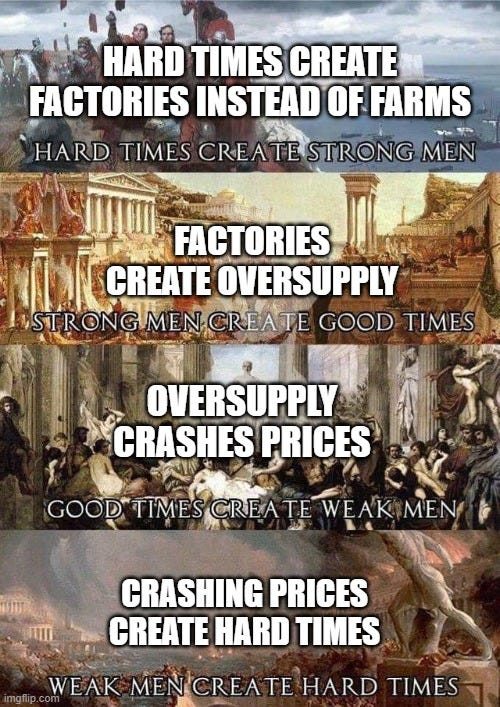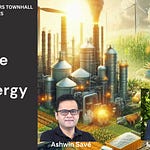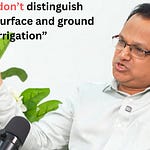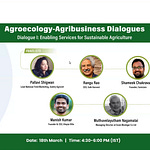Whenever I sit down with friends from the aquaculture industry to corroborate the industry dynamics of aquaculture vis-a-vis agriculture, I am often left wondering: Is aquaculture agritech on steroids?
Few weeks ago, I invited Pavan Kosaraju (AquaExchange), Aditya Dash (Frozen Shrimp Exporter), and Willem van der Pijl (Shrimp Insights) to explore this question and survey the State of Aquaculture in 2024 as part of ABM Townhall Dialogue series.
Our resident ABM community manager Will and esteemed ABM Members Rajneesh and Sreeram Raavi -with whom I had the opportunity to explore “The Art of Happy Agritech Exit” after Nutreco, a Dutch producer of animal nutrition, fish feed and processed meat products, acquired Eruvaka, - also joined us in the dialogue.
At one level, the answer to this question is obvious.
As Aditya rightly points out in this dialogue, the per-hectare value of innovation in aquaculture is much higher when compared to agriculture, and on an animal protein basis, the technology is far more advanced when compared to poultry or goats.
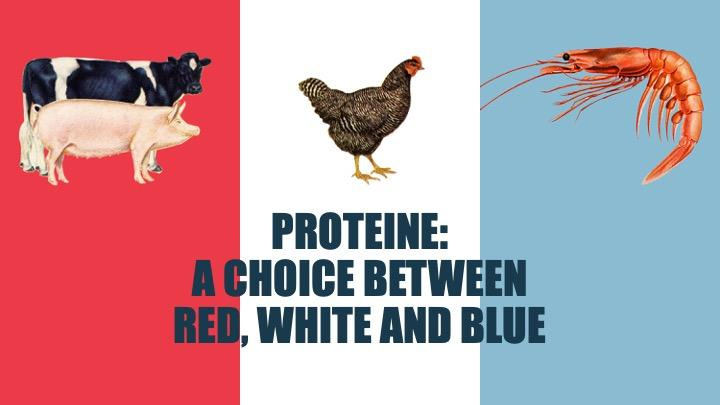
And yet, today, given the extent of volatility in the market prices, a chilli farmer has a far higher likelihood of making money than a shrimp farmer. How do we peel the onion of this predicament?
Early on in the dialogue, Willem peeled the first layer of the onion - what happens when the industry cannot absorb so much growth? For a long time, the prices were relatively strong that anyone could make money even if you had a shitty crop.

“The average value/kg for Ecuador in January and February dropped to $4.36, the lowest ever. For India, the average value fell to $5.67 in January 2024 and $5.38 in February 2024, just above the lowest point of August 2023.”
And when you understand the production dynamics of different markets - Asia, with its smallholder farmer dynamics vis-a-vis plantation-style farms of Latin America - you peel the second layer of the onion.
Pavan shared that this debate of aquaculture vis-a-vis agriculture has been happening across several Indian states - Should an aquaculture farmer get the same perks of subsidised electricity enjoyed by a farmer practising agriculture?
Earlier in January, Pavan had recently raised $6 Million to build and scale a “reinforcement framework, wherein farmers are immediately incentivised for sustainable practices through reduced input costs and higher offtake prices, emphasizing our commitment to sustainable practices in the industry.”
Given the context of where aquaculture is today, I asked Pavan to double-click on “reinforcement framework” to understand the role of technology in fundamentally transforming the economics of production in aquaculture.
Pavan gave a fascinating glimpse into the advanced stage of the evolution of insurance in aquaculture: Farmers were able to claim and settle insurance for disease action.
Contrast this with the baby steps the agri-input biologicals industry is making on bundling with insurance. Didn’t I tell you that aquatech was agritech on steroids?
But why is this the case? Aditya gave a powerful insight into the evolution of aquaculture which plays out almost like the famous Roman meme that has been going viral in social circles.
Aditya summed up the fundamental predicament: While the value chain hasn’t changed, the business model has radically changed over the past several decades.
In this ABM Townhall dialogue, we explored various salivating questions that gave me a deeper sense of the forest over trees in the aquaculture ecosystem:
How do we understand the evolution of this “young sector” called aquaculture - Would it inevitably go the path of consolidation and vertical integration or would this sector buckle this trend?
Has there been oversupply in the past? How do we shift the needle in changing the demand curve for the consumption of shrimp (with a case study on the Global Shrimp Council)? What happens when an industry moves from an immature to a mature state? How do we address the concerns raised by recent publications casting aspersions on the quality, sustainability and social responsibility of the Indian shrimp industry?
Can the shrimp industry learn something from the salmon ecosystem with the top 12 players accounting for 70% of the global production? How to get farm managers to believe that technology will work to their advantage and not to their disadvantage?
Agritech has been toying with “Farming as a Service” for a very long time. Can agritech learn something from aquatech which has a longer stint of experience with farming as a service model? (Case study on Delos) When benefits of scale are not accruing to small farmers, should aquatech players become virtual consolidators?
Why is shrimp farming a lot like gambling? How can tech change this perception in the ecosystem, especially among lenders? Should technology be directed towards upstream or downstream in aquaculture? What developments are we seeing in grading and sorting in aquaculture? With its low-cost labour, what role will India play in the aquaculture ecosystem when grading and sorting technologies mature?
India recently announced a Blue Economy blueprint and there is a lot of hope riding on the blue economy. The targets set by the Pradhan Mantri Matsya Sampada Yojana (PMMSY) for aquaculture are:
Increasing fish production to 22 million metric tons by 2024-25 from 13.75 million metric tons in 2018-19.
Enhancing aquaculture productivity to 5 tons per hectare from the current national average of 3 tons.
Augmenting domestic fish consumption from 5 kg to 12 kg per capita.
How do we achieve these targets? What are the challenges in skilling the labour for fish processing? What can we learn from the automation of salmon filleting?
How did Latin America achieve success in aquaculture through collaboration? How is Ecuador pushing India to strengthen its domestic economy and improve its perception of quality and sustainability? What are the parallels between Ecuador and Brazil in the context of aquaculture and agriculture?
What are the commonalities in building trust among consumers in the context of aquaculture and agriculture? Who has better incentives aligned to pay for transparency and traceability? How do we understand the parallels in the dynamics happening between farmed shrimp vis-a-vis wild catch shrimp?
How do we make sustainability practices become self-serving endeavours for farmers? How do we reduce the cost of maintaining records?
Are we seeing an irreversible shift towards aqua proteins because it’s healthier and more sustainable? How do we understand the behavioural change in urban consumers in the animal protein category? How to adapt shrimp for Indian kitchens? How do we bring a cultural shift in culinary preferences for aqua protein?
Why do we need to go beyond the frozen and fresh category, when it comes to shrimp to promote consumption? What are the ready-to-eat and convenience-driven market plays in shrimp that are worth paying attention to? Why do China’s margins create an opportunity for those of us in India? What parallels can we draw between grapes and shrimps, in the context of exports?
Is the market demanding more certified farmed shrimp instead of wild-caught shrimp? How to understand the connoisseur-driven fragmentation and its certification systems for the wild-caught shrimp market?
How do we address the concerns of Climate change and overfished oceans, courtesy of movies like Seaspiracy? How do we understand the demand for sustainable shrimp? Is the demand for certification coming from retail or regulatory pressures? Would regulatory tech compliance evolve in aquatech as much as we are seeing in agritech?
I learned a lot from this conversation and it was a fascinating exercise exploring the convergences and divergences between agritech and aquatech. I hope you find it equally interesting.:)
So, what do you think?
How happy are you with today’s edition? I would love to get your candid feedback. Your feedback will be anonymous. Two questions. 1 Minute. Thanks.🙏
💗 If you like “Agribusiness Matters”, please click on Like at the bottom and share it with your friend.



